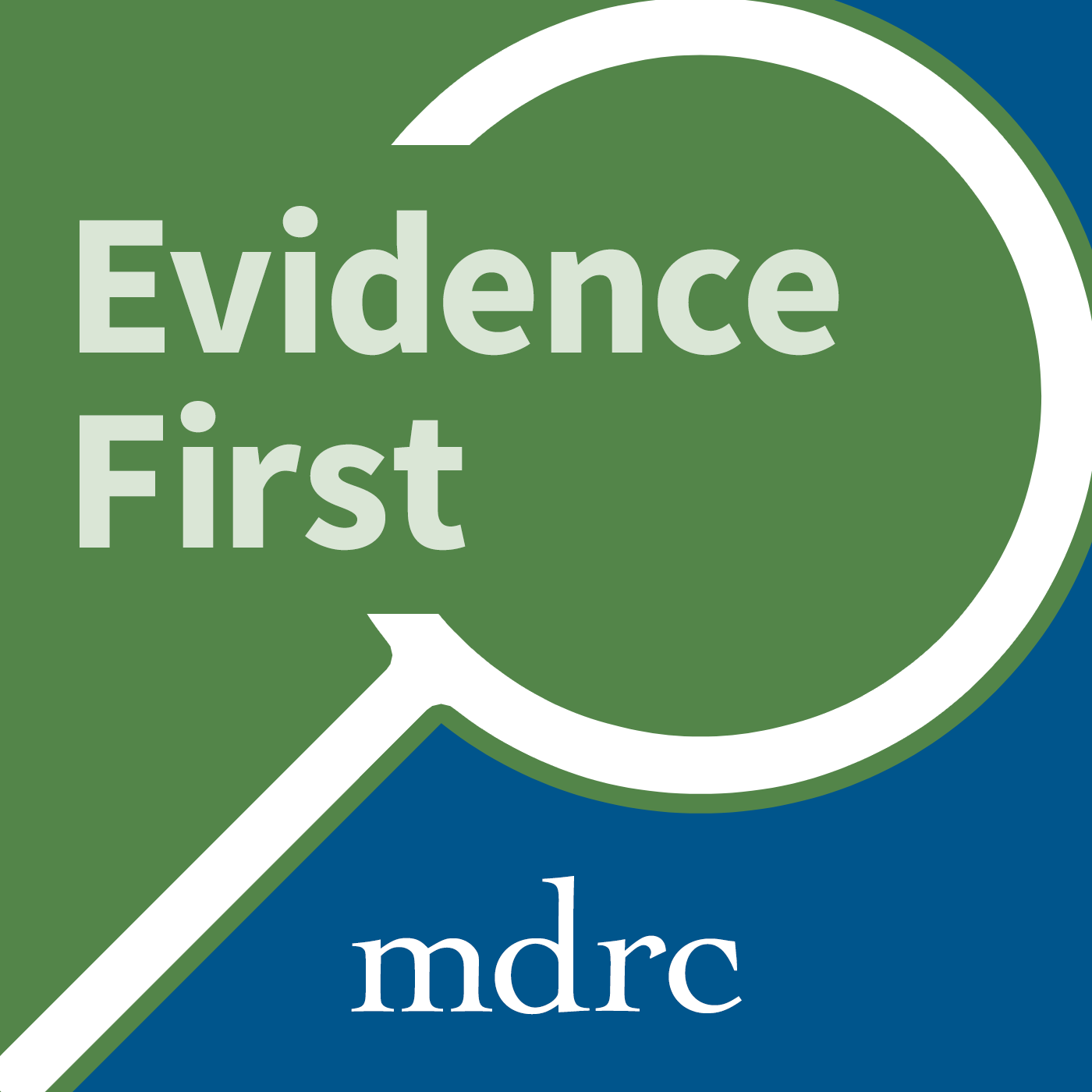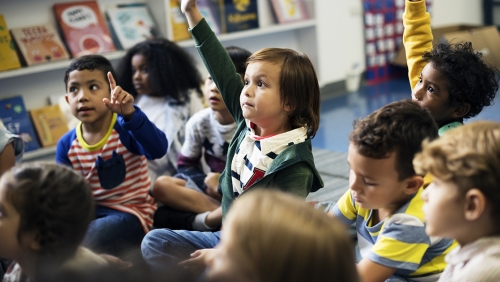
Host: Leigh Parise
Producers: Katya Manna and Jonny Poilpré
Policymakers talk about solutions, but which ones really work? MDRC’s Evidence First podcast features experts—program administrators, policymakers, and researchers—talking about the best evidence available on education and social programs that serve people with low incomes.
Latest Episode
Transcript
Leigh Parise: Policymakers talk about solutions, but which ones really work? Welcome to Evidence First, a podcast from MDRC that explores the best evidence available on what works to improve the lives of people with low incomes. I'm your host, Leigh Parise.
Educational institutions serving rural communities are severely understudied. Solutions that work for urban and suburban higher education systems may or may not translate to a rural context. MDRC, supported by the Institute of Education Sciences (or IES), has announced the launch of the National Rural Higher Education Research Center. The center will work with partners across the country to conduct eight research studies in two regions, the South and the Mountain West, to learn what works to help rural students enroll in and complete college.
Today we're joined by Alyssa Ratledge, a research associate at MDRC studying postsecondary education. If her name sounds familiar, that's because Alyssa is one of MDRC's experts on rural higher education and she has joined us before to talk about MDRC's work in this space. I'm very pleased to say that she is here today to talk about this new MDRC center and what makes this work so exciting. Alyssa, welcome back to Evidence First.
Alyssa Ratledge: Thank you, Leigh. I'm so excited to share about the new center that we have.
Leigh Parise: Great. Alyssa, before we jump into the details, can you give us a little background on the history of higher education in rural areas—especially things like some of the particular challenges facing rural students and rural higher education institutions?
Alyssa Ratledge: Absolutely. In a lot of rural parts of the country, the local community college or regional four-year university is the only game in town for postsecondary education. One of the things that this means is that these colleges wear a lot of hats. They are providing traditional liberal arts and transfer pathways. They're providing trades and workforce training. They are also providing degrees for nurses and educators. And a lot of times they're the largest employers in their town, too. This is all happening despite being pretty seriously underfunded in a lot of states and serving enormous catchment areas geographically.
Imagine a college in a large Western state like Montana or Wyoming or Arizona (where I'm from). These colleges might be serving students for a hundred miles in every direction and needing to serve every educational and postsecondary need that those students might be looking for. So naturally this also has a pretty significant impact on the students themselves. Students who are living in rural areas often have to make really difficult decisions about where to go to college or how to attend college in a way that students [who live] in a city that has many colleges in it just are not going to have to grapple with. Students have to decide if they're ready to take on the long drive to campus every day [and] think about how they're going to juggle their other responsibilities like working or caregiving.
A lot of times we hear that students or families are really skeptical about their kids going off to college because oftentimes, for our small towns, those students don't come back. How [do] we think about filling local workforce needs when the risk for that training is that students might not come home—[which] is a pretty significant one. We also know that in a lot of places in the country, there's no good internet quality, so there's no way to supplement your classes with online courses or online options. Ultimately, for students in their communities, it's this local college or nothing. And a lot of times they're getting a great experience there, but they are going to have a lot more challenges than students in a city might.
Leigh Parise: Right. That sounds like a lot of different things—different roles, different students, different kinds of distances, changes in the jobs that might be available for students. I see why this is deserving of its own center, its own focus.
One other question before we start to talk about what the center will be focused on: Can you say a bit about how you think the educational needs—specifically of rural areas—have been changing in recent years?
Alyssa Ratledge: One of the big disruptions has been changes in local economies. If you think about some of the different rural parts of our country, you can imagine what this looks like: Mines are closing, factories are closing, farms are consolidating, fisheries are closing. These are the kinds of jobs that historically didn't require higher education and often employed huge swaths of the counties and towns that they were in. At the same time, the main growth areas for jobs today are in things like nursing and teaching—so things that require higher ed—or in the traditional roles, things that do require additional workforce training: things like robotics or engineering to work on solar farms or factory farms today.
So it looks really different from how those economies looked before, and colleges are the ones that need to step in to fill those workforce needs and respond to demand from the community for what people are doing today.
Leigh Parise: Would you say that is something that we're seeing in rural areas across the country? I know the new center is going to be focused on the South and the Mountain West, but I also know that you've done work in other places as well, so I'm curious if this is a trend that you think is common across a lot of different rural areas in the U.S.?
Alyssa Ratledge: Yes, I think it is. I think that the specific jobs and pathways look a little different. Some parts of our country are going to see farms consolidate rather than close. Some places are going to see wind farms and solar farms pop up in places that historically had mines. Other places, we're seeing different ways to adapt to the same kinds of jobs: using modern forestry techniques, for instance. Forestry itself has not changed, but the way that we approach it and the kind of training required does look a little bit different.
Leigh Parise: That's really helpful, thank you.
All right. So tell us, what have been some of the limitations of previous research studying rural higher education?
Alyssa Ratledge: Unfortunately, for a long time, rural colleges and rural students have not appeared very often in postsecondary research, and this is partially for the very obvious reason of sample size. If you're working with a college that takes in a hundred new students every fall, it's going to be really hard to get a good sample size for a research study compared to a college that's bringing in 2,000 new students every fall. That's a big part of it.
Another part, though, is a lot of our small rural colleges approach interventions and approach college policies a little bit differently. A story that I like to tell is about a project I worked on in Wisconsin several years ago, where we were purposely trying to recruit a mix of large urban colleges, suburban colleges with satellite campuses, and some small rural colleges. In our large urban colleges and even in our suburban colleges, they were really interested in how we could make big scalable changes to how students were placed into remedial coursework.
But I remember a conversation with a faculty member in a small rural college who said, "Well, I don't think I need any of those fancy things because we get about 70 new students every fall and I just talk to all of them." It really was a light bulb moment for me—to say, "Oh, right, if you're getting 70 new students every fall, you can just talk to them and figure out how to place them in classes." It is a very different approach to how you're going to implement those kinds of policies in small rural colleges.
Leigh Parise: I have heard you talk about some of the exciting innovation happening in rural areas. I don't know if you want to share a little bit about what you feel have been some of the limitations in previous research, in terms of its ability to highlight—or perhaps it's left some gaps in terms of being able to identify some of those innovations.
Alyssa Ratledge: Sure. I think that a lot of our rural colleges are doing really innovative things and responding to local labor market needs and quickly responding to demand in a way that some other colleges just don't have the ability to do. One thing that comes to mind is [that] a lot of our rural colleges are building into [their] programs the specific industry needs in their area.
For instance, if they are near tribal areas, they might be building tribal competency into their education and nursing programs. Or they might operate a teaching program where teachers are specifically taught how to offer multiple grade levels in the same classroom—knowing that, for many of our rural areas, teachers are not assigned to a specific grade level but are teaching all children, K-3, in a small classroom. Being able to adapt to those unique needs of their area allows them to train future teachers who are equipped to serve locally and are more likely to stay there, supporting the educational systems nearby.
Leigh Parise: That's a really good example. Thank you. Moving on to the center: Tell us about what topics the new rural higher education center will be exploring.
Alyssa Ratledge: I'm so excited about the center because it's going to provide new evidence about multiple stages of the postsecondary education pipeline. We're going to start back in high school dual enrollment. For those not familiar, this means that students in high school are able to take courses that both apply for their high school credits and apply to college credits. This is a really big topic in both K-12 and postsecondary right now, and we're undertaking a large study in three states—Alabama, North Carolina, and Tennessee—in partnership with Julie Edmunds at UNC to understand how the expansion of dual enrollment can help students in rural areas accumulate more credits and then transfer on to their college access and their college credit accumulation. It's really exciting and I think [it] will speak to a lot of the big topics in dual enrollment right now, both at the high school level and for the community colleges that are often the purveyors of those dual-enrollment credits.
From there, we're going to look at college access, with a particular focus on rural-serving college-access programs. We're partnering with Mara Tieken at Bates College to study how these programs operate in Oregon and Idaho. We're also partnering with Travis Smith at Auburn to do a deep dive on how rural Black youth in Alabama's Black Belt make decisions about going to college locally—especially [how they] think about their choices to attend predominantly White institutions or HBCUs (historically black colleges and universities).
Then when students get to college, we have two projects looking at how to support their persistence and success. The first one is Montana 10, which listeners of the podcast may recall is a study we're conducting with the Montana University system—[in] eight of their colleges across the state, including their flagships, their regional publics, and their small rural community colleges. This is a multifaceted student support program designed to help rural students be successful, whether they are going to their local college or going to a big city like Missoula or Billings to attend college.
Our final project in this space is in partnership with WICHE (the Western Interstate Commission for Higher Education), which is studying train-in-place rural nursing programs in very rural parts of Colorado, New Mexico, and Wyoming. How can we allow future nurses to get training—partially at home, partially remotely, and partially in a larger town—that they'll then be able to apply to significant nursing shortages in rural parts of those states? [How can we] get them to and through those programs and completing their nursing certificate?
In addition to these studies, our partner Nick Hillman at University of Wisconsin-Madison is doing a national study to look at rural students' college access and completion all across the country, using National Student Clearinghouse data and a couple of federal datasets in a way that's never been done before. We've never been able to cut the data in a way to understand how rural students are making college access choices.
So it's a really ambitious research scope. It's going to answer some really important questions about college preparation, college access, and importantly, college completion. So not just Can we get students prepared, not just Can we get them in, but Can we do it all the way to graduation and get students to the achievement that they are looking for.
I'm really excited, too, that all of these studies are designed to answer questions that we hear. We hear from state agency leaders, we hear from college presidents, we hear from faculty in rural colleges. These [projects] are answering real questions that they have, and we're making sure that every study has research products that will explain the findings in a clear and usable way so that others across the country—in rural colleges and rural states—can apply them too.
Leigh Parise: That's great. That last part, I think, is so critical: helping to make sure that we are sharing what we are doing and we are helping people in rural communities across the country be able to make connections to whatever is happening in their own local context and understand how lessons from a particular state or particular rural area will apply to them.
I also love the whole pipeline approach that the center has taken. I think sometimes we do a study that is focused on one particular slice and we almost always have questions about "Well, what happened before that? How did people make decisions? What were their experiences in high school that might have led them to this particular college or this particular major?" And so I love that we are going to be able to answer some questions that really cross that entire pipeline and both qualitatively [ask], "How are people making decisions and what does this look and feel like for students?" and then be able to actually look at their outcomes. So that's great.
Alyssa Ratledge: I totally agree. I personally feel a lot of responsibility for making sure that we approach this work in the right way, and that larger pipeline approach, I think, will really help us understand how students are experiencing each of those pieces and how institutions can learn from each other.
The other thing I want to brag about, very quickly, is that we brought on a set of 10 practitioner advisors representing every region of the country to provide feedback and direction to the research—to keep us on track and make sure the research is useful for people who are doing this work day-to-day. I'm really excited about our ability to both learn from them but then also share back out to them and their colleagues how we can improve the day-to-day for students.
Leigh Parise: That's a really cool part of this project. I love that it is advisors from across the country because I think they're going to be able to help you connect some of those dots that I was asking about earlier: "Well, how does what you're learning in the Mountain West apply in various regions of the country?" That's really exciting and a great innovation to see as part of the center.
Alyssa, if there are rural practitioners or researchers or others listening who want to be kept up-to-date, what's the best way for them to do that?
Alyssa Ratledge: I would absolutely love to hear from them. If you are a rural practitioner who wants to stay up-to-date or wants to provide feedback on the center's research strategy, you can reach out to me by email here at MDRC: RuralHigherEd@mdrc.org
I will put you on a list serve and would love to hear your feedback. For researchers, several of the lead researchers here in the rural center will be attending the Association for the Study of Higher Education Conference in Minneapolis from November 20th through 23rd. We'd love to connect with you in person there. If not, drop us a line. Happy to connect you to any of the research staff here who are really excited and eager to talk about what's coming next.
Leigh Parise: That's great. Thank you. Alyssa, thank you so much for joining. This is so exciting and I know that tons of students and colleges and systems are going to benefit from this work, and I'm honestly so thrilled that IES is investing in this and more work in the rural space.
Alyssa Ratledge: Thanks, Leigh. I was so delighted to join today.
Leigh Parise: To learn more about the National Rural Higher Education Research Center, visit mdrc.org. Did you enjoy this episode? Subscribe to the Evidence First podcast for more.
Both college-going and college completion rates are far lower in rural areas than in other geographical settings. To learn what works to help rural students enroll in and complete college, MDRC, supported by the Institute of Education Sciences (IES), has launched the National Rural Higher Education Research Center. The center will work with college systems to conduct eight research studies in two regions: the South and the Mountain West.
In this episode, Leigh Parise talks with Alyssa Ratledge, research associate at MDRC, about the research questions the Center will address in response to the needs of rural practitioners and policymakers.










